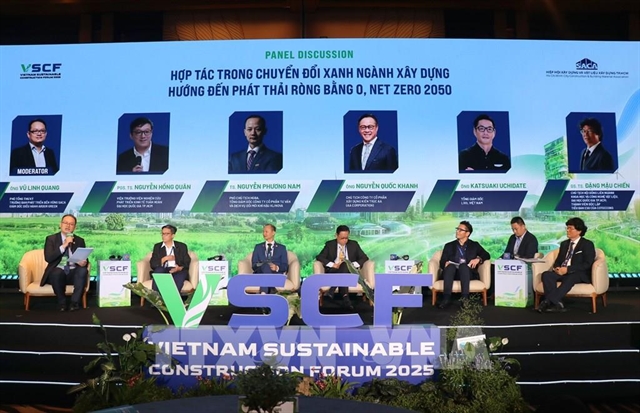 Economy
Economy

 |
| A road upgrade being carried out in Đồng Tháp Province. — VNA/VNS Photo |
ĐỒNG THÁP — The southern province of Đồng Tháp is making a concerted push to accelerate disbursement of public investment, determined to fully achieve the year’s target.
According to its People’s Committee, Đồng Tháp has set out a series of urgent measures to overcome bottlenecks in land clearance, contractor selection and administrative procedures.
Local authorities are working with a clear directive: to accelerate project implementation while ensuring quality and accountability at every level.
Chairman of the People’s Committee Trần Trí Quang recently urged heads of departments and districts and commune-level authorities to show “strong determination and personal responsibility” in advancing delayed projects, particularly those hindered by site clearance issues.
“We must work closely with local people, listen to their concerns, and find reasonable, lawful solutions so that no project is left stagnant due to administrative inertia,” he said at a meeting with investors and construction units earlier this month.
For projects carried over from previous years, Đồng Tháp has directed contractors to speed up construction and immediately proceed with acceptance and payment once measurable work is completed.
It has also ordered internal capital reallocations among project owners to ensure that funds are used effectively and do not remain idle in the system.
Newly approved projects are also being fast-tracked, with the province accelerating the process of contractor selection and urging investors to commence construction as early as possible.
To further facilitate progress, the local government has instructed its various departments to finalise compensation and resettlement documents, resolve legal and administrative obstacles, and strengthen communication campaigns to help local communities understand and support government policies on land acquisition.
The province has temporarily advanced money from its Land Development Fund to pay compensation and complete land clearance, ensuring that project timelines are not delayed by financial bottlenecks.
This year Đồng Tháp has been allocated more than VNĐ17.559 trillion (US$700 million) in public investment, including VNĐ5.744 trillion ($229 million) from the central coffers.
As of October it has disbursed VNĐ8.417 trillion ($336 million), equivalent to 60 per cent of the approved plan and placing it among the best performing localities nationwide in terms of disbursement rate.
Đồng Tháp is also working with central ministries on two major proposals to be financed through Official Development Assistance.
One involves construction of a coastal road running through the province and linking it with Long An and Vĩnh Long provinces, and the second is the Đồng Tháp sub-project under the Climate Resilience and Integrated Transformation Programme for the Mekong Delta (WB11).
Both are expected to enhance the province’s connectivity, climate resilience and socio-economic development in the coming decade.
However, despite its progress, Đồng Tháp still faces numerous challenges that threaten to slow the pace of disbursement.
One of the main obstacles is completing legal procedures for land acquisition.
Many investors have been unable to finalise land allocation due to issues such as missing land use certificates, ownership disputes, absentee landholders, or incomplete verification of agricultural households eligible for compensation.
Furthermore, the overlap between the Law on Investment and the Land Law in defining project approval and investor selection procedures has created confusion and delays for both local authorities and businesses.
These legal inconsistencies often result in prolonged administrative reviews and hesitation in granting final project approvals.
Adding to the complexity is a shortage of construction materials, particularly sand.
Rising sand prices have driven overall costs beyond the original estimates in project budgets, prompting contractors to slow down work while awaiting updated construction price indexes that reflect market conditions.
This in turn has delayed the completion of several infrastructure projects across the province.
Land clearance remains one of the toughest challenges.
Though Đồng Tháp has allocated additional funding to accelerate compensation payments, a number of projects are still stalled due to disputes or public unhappiness with compensation policies.
In some areas, inadequate communication about State regulations on compensation and resettlement has led to misunderstandings and long-standing complaints.
Authorities have acknowledged these issues and instructed all relevant agencies to strengthen on-the-ground dialogue and public consultations to achieve consensus.
They are also preparing for potential administrative restructuring as part of the national plan to streamline local governments.
The People’s Committee has directed departments to carefully coordinate the handover of transitional projects to avoid any disruption in management or disbursement caused by the merging or realignment of administrative units.
To further enhance efficiency, the Department of Finance has been tasked with proposing optimal methods for accelerating disbursement, while the Department of Construction will draft a directive linking the responsibility of each project leader to specific disbursement outcomes.
Those who fail to meet progress targets without valid reasons will be held accountable.
According to the provincial People’s Committee, the first 10 months of 2025 have seen positive momentum in public investment, with a number of key infrastructure projects moving forward, including road construction, irrigation systems and education and healthcare facilities.
The province expects that with continued determination from all levels of government, and stronger collaboration between public agencies and contractors, the final months of the year will see a surge in disbursement activity. — VNS